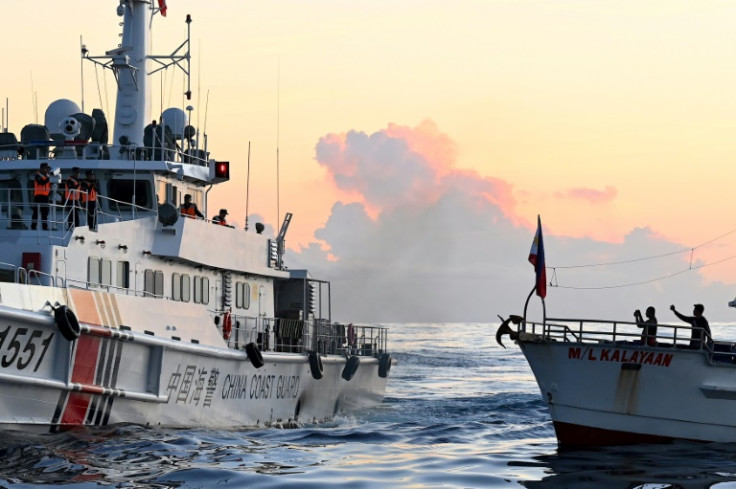
KEY POINTS
- The Philippine Navy issued five "radio challenges" to a Chinese destroyer that did not respond
- China's PLA said it was also conducting "routine" patrols in the area
- The PCG said a Chinese Coast Guard vessel "rammed" a Philippine boat last month
Two Chinese warships tailed naval vessels from the United States and Philippines that were conducting their second joint maritime patrol in the South China Sea on Wednesday.
The People's Liberation Army (PLA) guided missile destroyer Hefei and frigate Huangshan shadowed the patrolling U.S. and Philippine forces "all day," local outlet GMA News reported.
The Chinese battleships "sailed from a distance" and "observed" the allied vessels that were patrolling areas within the Philippines' exclusive economic zone (EEZ), the report said.
The Philippine Navy vessel reportedly delivered a "radio challenge" to the Chinese destroyer, telling it that the Hefei was "within Philippine exclusive economic zone" and its refusal to respond will be reported to the authorities concerned. The radio messages were repeated five times but the warship did not respond.
The Armed Forces of the Philippines (AFP) commenced its second joint "maritime cooperative activity" with the U.S. in the West Philippine Sea earlier on Wednesday.
The Armed Forces of the Philippines (AFP) and the United States Indo-Pacific Command (USINDOPACOM) commence the second iteration of the maritime cooperative activity in the West Philippine Sea from January 3 to 4, 2024.
— Armed Forces of the Philippines (@TeamAFP) January 3, 2024
(Photos from WESCOM, AFP)#AFPyoucanTRUST pic.twitter.com/Bfx8CYjiPN
Soon after, the PLA's Southern Theater Command said its naval and air forces were conducting "routine patrols" in the disputed South China Sea as the troops "remain on high alert at all times."
The U.S. and Philippines held their first joint patrol in the disputed waters in November amid China's increasing aggression in the area.
Since the first maritime patrol, tensions have escalated between the Chinese Coast Guard (CCG) and the Philippine Coast Guard (PCG).
Last month, the PCG said a CCG ship "rammed" a Philippine boat that was conducting a resupply mission near the Second Thomas Shoal – known as Ayungin Shoal in the Philippines and Ren'ai Jiao in China – in the disputed Spratly Islands.
A day before the incident, Manila accused Beijing's coast guard of using water cannons to "obstruct" three Philippine government boats that were delivering supplies to fishermen near another disputed territory, the Scarborough Shoal – the Philippines calls it Bajo de Masinloc, or Panatag Shoal, and China refers to it as Huangyan Island.
Following the water cannon incident, Philippine President Ferdinand "Bongbong" Marcos Jr. issued a long statement, calling out the CCG and Chinese Maritime Militia's "aggression and provocations" in the West Philippine Sea. He said China's actions "only further steeled our determination to defend and protect our nation's sovereignty."
The aggression and provocations perpetrated by the China Coast Guard and their Chinese Maritime Militia against our vessels and personnel over the weekend have only further steeled our determination to defend and protect our nation's sovereignty, sovereign rights, and…
— Bongbong Marcos (@bongbongmarcos) December 10, 2023
Marcos Jr. later clarified that while his country will continue to adhere to peace, it will also "forge strong alliances with allies to maintain regional stability." China has repeatedly criticized the Philippines' alliance with the U.S.
𝐏𝐇 𝐚𝐝𝐡𝐞𝐫𝐞𝐬 𝐭𝐨 𝐩𝐞𝐚𝐜𝐞 𝐛𝐮𝐭 𝐰𝐢𝐥𝐥 𝐟𝐨𝐫𝐠𝐞 𝐬𝐭𝐫𝐨𝐧𝐠 𝐚𝐥𝐥𝐢𝐚𝐧𝐜𝐞𝐬 𝐰𝐢𝐭𝐡 𝐚𝐥𝐥𝐢𝐞𝐬 𝐭𝐨 𝐦𝐚𝐢𝐧𝐭𝐚𝐢𝐧 𝐫𝐞𝐠𝐢𝐨𝐧𝐚𝐥 𝐬𝐭𝐚𝐛𝐢𝐥𝐢𝐭𝐲, 𝐬𝐚𝐲𝐬 𝐏𝐁𝐁𝐌
— Presidential Communications Office (@pcogovph) December 17, 2023
Maintaining peace and adhering to rules-based order remains the cornerstone
Despite Washington's continued show of support for Manila in its defiance toward China's aggression, Beijing still insists that nearly the entire South China Sea is under its territorial jurisdiction.
The Chinese government last year unveiled a new map that upgraded its infamous nine-dash line to a 10-dash line that now includes self-governing Taiwan and even India's Arunachal Pradesh.







